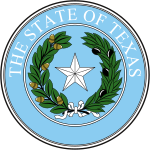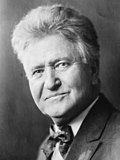| |||||||||||||||||||||||||||||||||
| |||||||||||||||||||||||||||||||||
 County Results
| |||||||||||||||||||||||||||||||||
| |||||||||||||||||||||||||||||||||
| Elections in Texas |
|---|
 |
|
|
The 1924 United States presidential election in Texas took place on November 4, 1924, as part of the 1924 United States presidential election. State voters chose 20 representatives, or electors, to the Electoral College, who voted for president and vice president.
Ever since statehood, Texas had been very nearly the strongest state for the Democratic Party owing to its initial history being as a Deep South state based around slavery. Even during Reconstruction when African-Americans were briefly enfranchised, the Republican Party won just one statewide election, and after Redemption and the passing of a new constitution in 1876 the GOP became confined largely to areas of abolitionist German refugee settlement in the Hill Country,[1] and to a few South Texas counties where local Republican bosses could until 1920 outcompete their Democratic equivalents.[2] The Terrell Election Law created a poll tax that, from 1902, disenfranchised virtually all remaining African-American voters, the vast majority of Mexican Americans, and also most poor whites.[3] Voter turnout among males over twenty-one fell from over eighty percent to under thirty percent following the poll tax.[4]
The period following this disfranchisement nonetheless saw a considerable amount of typically "Progressive" reform under Governors James Stephen Hogg and Thomas M. Campbell, and despite this progressive faction ceding power in 1906 to the conservatives, Texas proved solid in its support for progressive candidate Woodrow Wilson at the 1912 Democratic National Convention.[5] Another populist, James Ferguson, took the governorship in 1914 on an anti-Prohibition platform, but was impeached for misappropriation of public funds.[6]
1916 had seen Democrat Woodrow Wilson establish firmer control over the machine-dominated areas of South Texas, but hostility towards Wilson's peace promises caused some losses amongst the German population.[7] Later Wilson became hated by German and Irish Americans for his entry into the war, his role in drafting the Treaty of Versailles and supporting many anti-German groups during the "Red Scare".[8] His League of Nations proposal was also opposed in the South where isolationism had long been very powerful,[9] but the reaction was much less pronounced than in Acadiana or the Ozarks.[9]
At the beginning of the campaign, the victory in the tantamount-to-election Democratic primary for Governor of Miriam A. Ferguson in opposition to the powerful Ku Klux Klan produced substantial doubt about whether Democratic nominee John W. Davis of West Virginia would maintain even James M. Cox’s reduced vote share from 1920,[10] with suggestions some of her supporters would back incumbent Republican president Calvin Coolidge or Progressive nominee Robert M. La Follette.
- ^ Bass, Jack (1995). The Transformation of Southern Politics: Social Change and Political Consequence Since 1945. University of Georgia Press. p. 25. ISBN 0820317284.
- ^ Weeks, O. Douglas (August 1930). "The Texas Mexican and the Politics of South Texas". The American Political Science Review. 24 (3): 606–627. doi:10.2307/1946929. JSTOR 1946929.
- ^ Davidson, Chandler (March 10, 1992). Race and Class in Texas Politics. Princeton University Press. p. 21. ISBN 0691025398.
- ^ Davidson; Race and Class in Texas Politics, p. 24
- ^ Grantham, Dewey W. (July 11, 2014). The Life and Death of the Solid South: A Political History. University Press of Kentucky. pp. 50–52. ISBN 978-0813148724.
- ^ Warren, Kenneth F. (April 4, 2008). Encyclopedia of U.S. Campaigns, Elections, and Electoral Behavior. SAGE Publications. p. 788. ISBN 978-1452265872.
- ^ Murrin, John M.; Johnson, Paul E.; McPherson, James M.; Fahs, Alice; Gerstle, Gary. Liberty, Equality, Power: A History of the American People (Concise ed.). p. 532. ISBN 1285545974.
- ^ Hough, Jerry F. (2006). Changing Party Coalitions: The Mystery of the Red State-Blue State Alignment. Algora. pp. 83–86. ISBN 0875864082.
- ^ a b Phillips, Kevin P.; The Emerging Republican Majority, p. 211 ISBN 9780691163246
- ^ Hart, Albert Bushnell (December 1924). "The Presidential Election in the United States". Current History. 21 (3). University of California Press: 325–328, 436–438. doi:10.1525/curh.1924.21.3.325.


